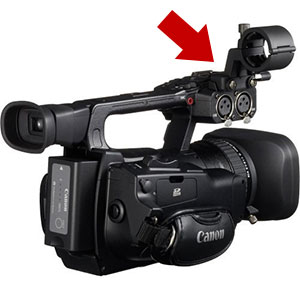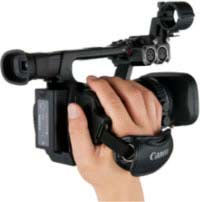There are certain elements that make a camera very appropriate for documentary filmmaking, and certain drawbacks that doc filmmakers need to be aware of before purchasing. Here is a list of criteria to keep in mind when you’re evaluating a camera for documentary filmmaking:
1. Audio Options – XLR Inputs?
 Documentary filmmakers often need to use boom microphones or lav microphones to their subjects to get adequate sound. XLR inputs (pictured on the left on the Canon XF100
Documentary filmmakers often need to use boom microphones or lav microphones to their subjects to get adequate sound. XLR inputs (pictured on the left on the Canon XF100) are ideal for documentary film cameras, but even if your camera or DSLR doesn’t have XLR inputs, you can often use an XLR breakout box
to plug in professional XLR-based microphones.
2. Autofocus?

Sometimes in the midst of a fast-paced volatile situation, filmmakers need to turn on autofocus, even if they usually shoot in manual focus mode. This means most DSLRs are not ideal, since the majority of them are manual focus only in video mode (though the Panasonic LUMIX DMC-GH4
and its lower-priced predecessor, the GH3
are notable exceptions that do have autofocus). The camera pictured to the left is the Sony PMW150
, a traditional video camera with excellent autofocus capabilities.
3. Size & Weight?
 Documentary filmmakers often find themselves following subjects for an entire day in the life, and that also means lugging gear around. So weight is a major area of concern, more so than for narrative filmmakers taking a more leisurely pace with a larger crew that might only nab a few shots in a day. (The diminutive camera to the left is once again the Canon XF100
Documentary filmmakers often find themselves following subjects for an entire day in the life, and that also means lugging gear around. So weight is a major area of concern, more so than for narrative filmmakers taking a more leisurely pace with a larger crew that might only nab a few shots in a day. (The diminutive camera to the left is once again the Canon XF100 which features all sorts of advanced manual controls but also fits into your hand.) Another consideration for documentary film cameras is whether or not the camera can be easily camouflaged as a tourist’s still camera, in situations where video is not welcome. Some documentary filmmakers are picking up DSLRs for this very reason.
4. Low Light Performance?

Let’s face it: documentary filmmakers often find themselves in situations where there isn’t adequate light, but there’s no time to add light to the scene, or it’s not even possible to in the first place. This might happen when you’re following your subject down a dark alley, or sneaking around to get footage of a corporation polluting in the middle of the night, and using an on-camera LED light
just isn’t an option. So cameras with large size sensors that can capture more of the available light (even if it is low) can really come in handy. In this regard, DSLRs for documentary filmmaking (like the Canon 5DM3
pictured at left) can be a blessing, because their ISO can often be cranked up quite a bit and still provide usable footage.
5. Recording Medium?

Many years ago narrative filmmakers could get away with using cameras that documentary filmmakers wouldn’t even consider, like the Panasonic HVX200
. Not because its footage wasn’t awesome– it was– but because it was limited to shooting on extremely expensive P2 cards, and each card could only shoot a small amount of video before it had to be swapped. Today, luckily, documentary filmmakers have access to plenty of video cameras to choose from that shoot on readily available cheap formats like SDHC cards
that can record for hours without needing to be swapped. So you’ll definitely want to make sure you grab a camera that shoots on a widely available format that’s inexpensive enough to stock up on plenty of cards before you go out shooting.
Related:
Top DSLRs for documentary film
Top Video Cameras for Documentary Film
10 Accessories Your Documentary Film Camera Kit Needs
5 Things to Consider Before Buying A Documentary Film Camera